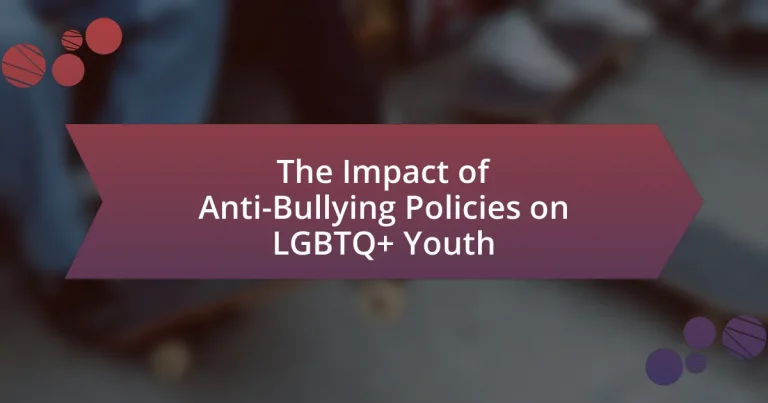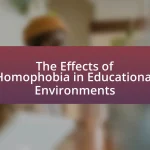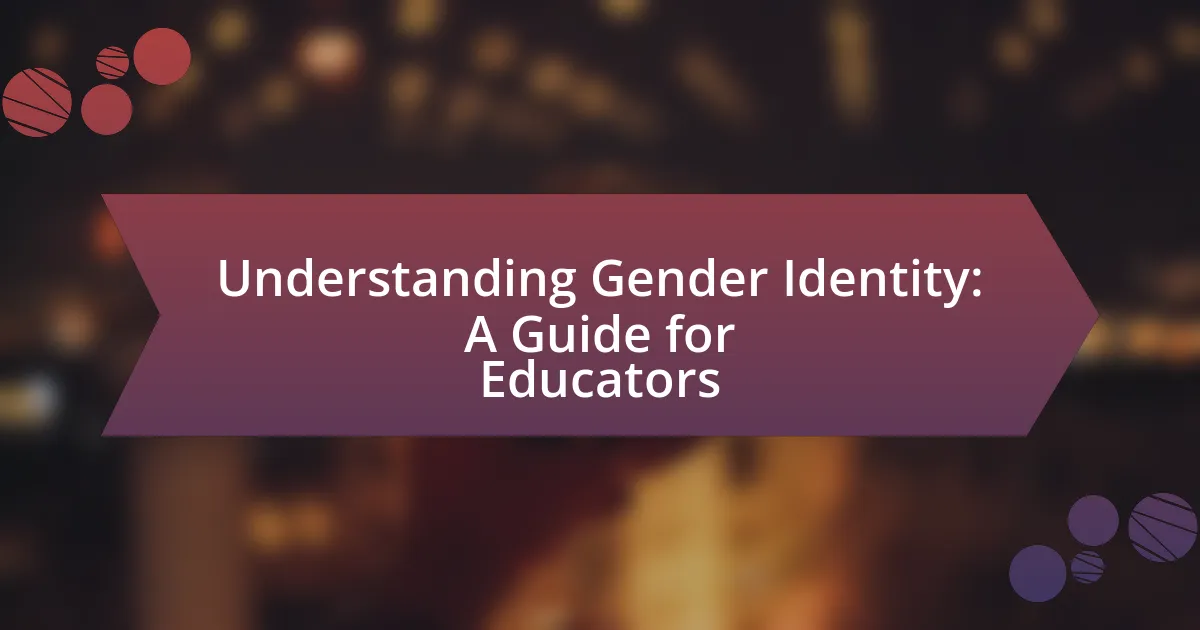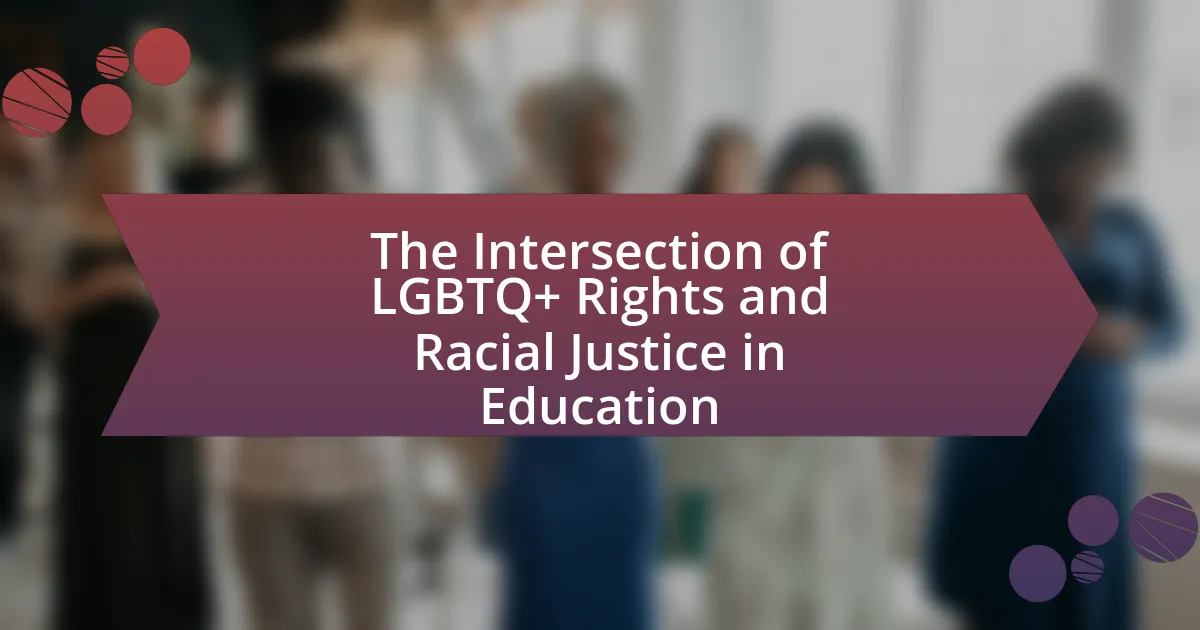Anti-bullying policies are formal guidelines established by educational institutions to prevent and address bullying, particularly focusing on the needs of LGBTQ+ youth. These policies aim to create a safe environment by defining bullying, outlining reporting procedures, and specifying consequences for offenders. Research shows that effective anti-bullying policies significantly reduce bullying incidents and improve the overall school climate, especially for marginalized groups. The article explores how these policies specifically protect LGBTQ+ youth, the key components of effective policies, the current landscape of implementation, and the impact of cultural attitudes and support systems on their effectiveness. Additionally, it highlights the challenges schools face in enforcing these policies and the positive outcomes observed since their implementation.
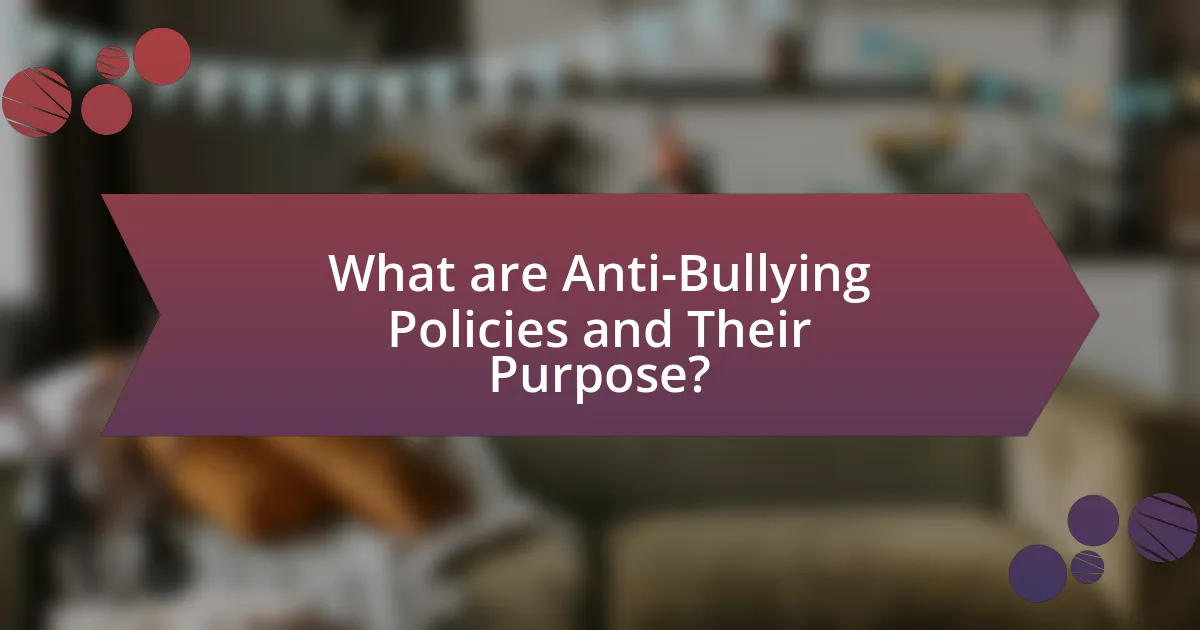
What are Anti-Bullying Policies and Their Purpose?
Anti-bullying policies are formal guidelines established by educational institutions and organizations to prevent and address bullying behavior among students. Their primary purpose is to create a safe and supportive environment for all students, including those from marginalized groups such as LGBTQ+ youth, by outlining clear definitions of bullying, procedures for reporting incidents, and consequences for perpetrators. Research indicates that effective anti-bullying policies can significantly reduce incidents of bullying and improve the overall school climate, fostering inclusivity and respect among students. For example, a study published in the Journal of School Psychology found that schools with comprehensive anti-bullying policies reported lower rates of victimization and higher levels of student well-being.
How do Anti-Bullying Policies specifically address LGBTQ+ youth?
Anti-bullying policies specifically address LGBTQ+ youth by incorporating explicit protections against harassment based on sexual orientation and gender identity. These policies often include definitions of bullying that encompass homophobic and transphobic behaviors, ensuring that LGBTQ+ students are recognized as a vulnerable group. For instance, the Gay, Lesbian & Straight Education Network (GLSEN) reports that schools with comprehensive anti-bullying policies that explicitly mention LGBTQ+ identities see lower rates of victimization among these students. Additionally, training for staff on LGBTQ+ issues is frequently mandated, promoting a safer and more inclusive environment.
What are the key components of effective Anti-Bullying Policies for LGBTQ+ youth?
Effective anti-bullying policies for LGBTQ+ youth include clear definitions of bullying and harassment, specific protections based on sexual orientation and gender identity, comprehensive reporting procedures, and mandatory training for staff and students. These components ensure that LGBTQ+ youth are recognized and protected within school environments, fostering a safe atmosphere. Research indicates that schools with inclusive policies see a significant reduction in bullying incidents, as evidenced by a 2019 study published in the Journal of School Psychology, which found that inclusive anti-bullying policies led to a 30% decrease in reported bullying cases among LGBTQ+ students.
How do these policies differ from general Anti-Bullying Policies?
Policies specifically addressing LGBTQ+ youth differ from general anti-bullying policies by focusing on the unique experiences and challenges faced by this demographic. General anti-bullying policies often address bullying in a broad sense without specifically acknowledging the intersectionality of sexual orientation and gender identity. In contrast, LGBTQ+-specific policies incorporate targeted measures such as inclusive language, training for staff on LGBTQ+ issues, and resources tailored to support LGBTQ+ students. Research indicates that schools with LGBTQ+-inclusive policies report lower rates of bullying and harassment against these students, highlighting the effectiveness of tailored approaches in fostering a safer environment.
Why are Anti-Bullying Policies important for LGBTQ+ youth?
Anti-bullying policies are crucial for LGBTQ+ youth because they create a safer and more inclusive environment, reducing the prevalence of bullying and harassment. Research indicates that LGBTQ+ youth face higher rates of bullying compared to their heterosexual peers, with studies showing that 70% of LGBTQ+ students experience verbal harassment in school settings. Implementing anti-bullying policies not only addresses these issues but also fosters acceptance and understanding, which can lead to improved mental health outcomes for LGBTQ+ youth. For instance, schools with strong anti-bullying policies report lower rates of suicide and self-harm among LGBTQ+ students, highlighting the direct impact of such policies on their well-being.
What statistics highlight the prevalence of bullying among LGBTQ+ youth?
Bullying among LGBTQ+ youth is alarmingly prevalent, with statistics indicating that approximately 70% of LGBTQ+ students experience bullying in school settings. A study by the Gay, Lesbian & Straight Education Network (GLSEN) found that 59% of LGBTQ+ students felt unsafe at school due to their sexual orientation, and 45% reported being bullied in the past year. Furthermore, the 2019 National School Climate Survey revealed that LGBTQ+ youth are more likely to face harassment based on their gender expression, with 62% of transgender students experiencing bullying. These statistics underscore the urgent need for effective anti-bullying policies to protect LGBTQ+ youth in educational environments.
How does bullying impact the mental health of LGBTQ+ youth?
Bullying significantly harms the mental health of LGBTQ+ youth, leading to increased rates of anxiety, depression, and suicidal ideation. Research indicates that LGBTQ+ youth who experience bullying are more likely to report mental health issues compared to their heterosexual peers. A study published in the Journal of Adolescent Health found that 42% of LGBTQ+ youth reported serious psychological distress, a rate significantly higher than that of non-LGBTQ+ youth. Furthermore, the Trevor Project’s National Survey on LGBTQ Youth Mental Health revealed that 39% of LGBTQ+ youth seriously considered attempting suicide in the past year, with bullying being a major contributing factor. These statistics underscore the detrimental effects of bullying on the mental well-being of LGBTQ+ youth.
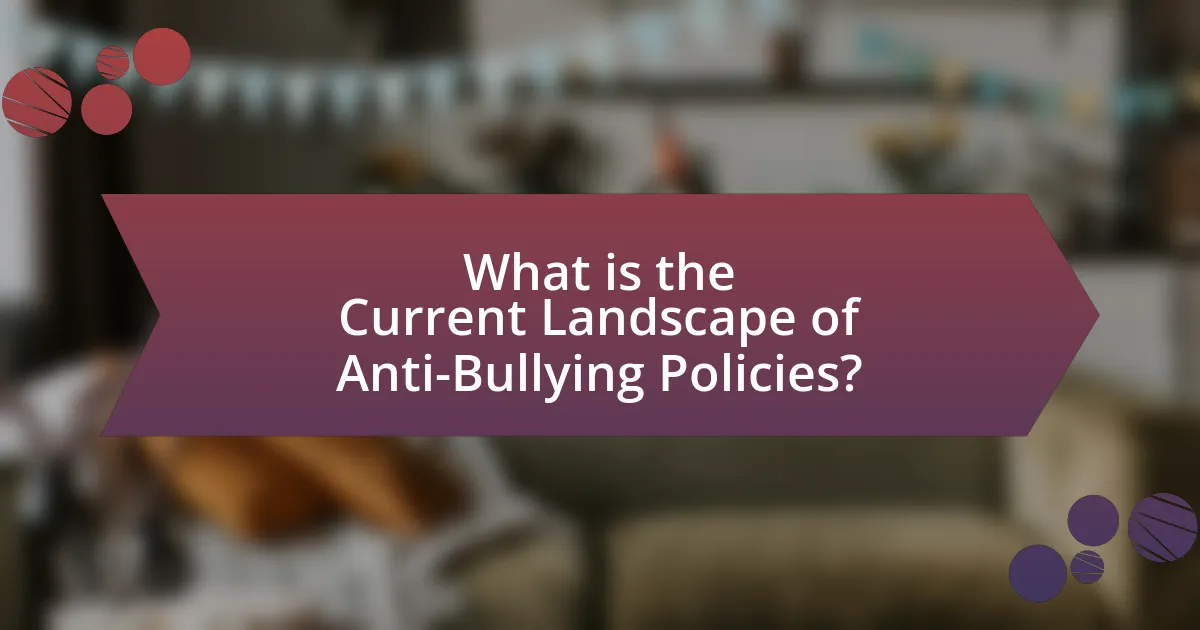
What is the Current Landscape of Anti-Bullying Policies?
The current landscape of anti-bullying policies is characterized by a growing emphasis on inclusivity and protection for marginalized groups, particularly LGBTQ+ youth. Many states and school districts have implemented comprehensive anti-bullying laws that specifically address bullying based on sexual orientation and gender identity. For instance, as of 2023, 23 states in the U.S. have laws that explicitly prohibit bullying based on sexual orientation, while 18 states include protections based on gender identity. Research indicates that schools with strong anti-bullying policies see a significant reduction in incidents of bullying and harassment, which is crucial for the mental health and well-being of LGBTQ+ students. Studies show that LGBTQ+ youth are at a higher risk for mental health issues when subjected to bullying, highlighting the importance of effective policies in creating safe educational environments.
How do different states or countries implement Anti-Bullying Policies?
Different states and countries implement Anti-Bullying Policies through legislative frameworks, educational programs, and enforcement mechanisms. For instance, in the United States, 49 states have enacted anti-bullying laws that require schools to develop policies addressing bullying, including provisions specifically for protecting LGBTQ+ students. These laws often mandate training for school staff and the establishment of reporting procedures. In contrast, countries like Canada have implemented comprehensive anti-bullying strategies that include community involvement and mental health resources, emphasizing inclusivity and support for marginalized groups. Research indicates that effective implementation of these policies can lead to a significant reduction in bullying incidents and improved mental health outcomes for LGBTQ+ youth, as evidenced by studies from the Gay, Lesbian & Straight Education Network (GLSEN) which highlight the positive impact of supportive school environments.
What variations exist in the enforcement of these policies?
Variations in the enforcement of anti-bullying policies for LGBTQ+ youth include differences in implementation across school districts, the level of training provided to staff, and the specific language used in the policies. For instance, some districts may have comprehensive training programs that equip educators to effectively address bullying, while others may lack such resources, leading to inconsistent enforcement. Additionally, policies that explicitly mention sexual orientation and gender identity tend to be enforced more rigorously compared to those with vague or general language. Research from the Gay, Lesbian & Straight Education Network (GLSEN) indicates that schools with inclusive policies report lower rates of bullying and harassment against LGBTQ+ students, highlighting the impact of policy specificity and enforcement on student safety.
How do cultural attitudes influence the effectiveness of these policies?
Cultural attitudes significantly influence the effectiveness of anti-bullying policies for LGBTQ+ youth by shaping the acceptance and implementation of these policies within schools and communities. When cultural norms promote inclusivity and support for LGBTQ+ individuals, anti-bullying policies are more likely to be enforced effectively, leading to a safer environment for these youth. Conversely, in cultures where negative attitudes toward LGBTQ+ individuals prevail, such policies may be undermined, resulting in inadequate protection and support for affected students. Research indicates that schools with a positive cultural climate towards diversity report lower rates of bullying and higher levels of student well-being, demonstrating the direct correlation between cultural attitudes and policy effectiveness.
What challenges do schools face in implementing Anti-Bullying Policies for LGBTQ+ youth?
Schools face significant challenges in implementing Anti-Bullying Policies for LGBTQ+ youth, primarily due to a lack of training for staff and insufficient resources. Many educators are not adequately prepared to address the specific needs of LGBTQ+ students, leading to inconsistent enforcement of policies. Research indicates that only 17% of school staff have received training on LGBTQ+ issues, which hampers their ability to effectively intervene in bullying situations. Additionally, schools often lack comprehensive data collection methods to monitor bullying incidents, making it difficult to assess the effectiveness of their policies. This combination of inadequate training and poor data management contributes to a failure in creating a safe environment for LGBTQ+ youth, as highlighted by the 2019 GLSEN National School Climate Survey, which found that 59.1% of LGBTQ+ students felt unsafe at school due to their sexual orientation.
What role do educators play in the success of these policies?
Educators play a crucial role in the success of anti-bullying policies aimed at protecting LGBTQ+ youth by implementing these policies effectively within the school environment. Their active engagement in creating a safe and inclusive atmosphere directly influences the emotional and psychological well-being of LGBTQ+ students. Research indicates that when educators receive training on LGBTQ+ issues and anti-bullying strategies, there is a significant reduction in incidents of bullying and harassment, fostering a more supportive school climate. For instance, a study published in the Journal of School Psychology found that schools with trained staff reported a 30% decrease in bullying incidents among LGBTQ+ students, demonstrating the impact of educator involvement in policy execution.
How can resistance from parents or communities affect policy implementation?
Resistance from parents or communities can significantly hinder the implementation of anti-bullying policies aimed at protecting LGBTQ+ youth. When parents or community members oppose these policies, it can lead to a lack of support from school boards and administrators, resulting in insufficient resources allocated for training and enforcement. For instance, a study by the Gay, Lesbian and Straight Education Network (GLSEN) found that schools with strong parental support for LGBTQ+ inclusive policies reported higher levels of implementation and effectiveness. Conversely, resistance can create a hostile environment that discourages educators from fully enforcing anti-bullying measures, ultimately undermining the safety and well-being of LGBTQ+ students.

What Evidence Exists on the Impact of Anti-Bullying Policies on LGBTQ+ Youth?
Evidence indicates that anti-bullying policies significantly improve the school environment for LGBTQ+ youth. Research conducted by the Gay, Lesbian & Straight Education Network (GLSEN) in their 2019 National School Climate Survey found that schools with comprehensive anti-bullying policies reported lower levels of victimization among LGBTQ+ students. Specifically, 60% of LGBTQ+ students in schools with such policies felt safe compared to only 40% in schools without them. Furthermore, the presence of supportive policies correlates with increased reporting of bullying incidents, leading to more effective interventions. This data underscores the positive impact of anti-bullying policies on the well-being and safety of LGBTQ+ youth in educational settings.
How have Anti-Bullying Policies changed the experiences of LGBTQ+ youth in schools?
Anti-bullying policies have significantly improved the experiences of LGBTQ+ youth in schools by providing a safer and more inclusive environment. These policies establish clear guidelines against harassment and discrimination, which helps to reduce incidents of bullying based on sexual orientation and gender identity. Research from the Gay, Lesbian & Straight Education Network (GLSEN) indicates that schools with comprehensive anti-bullying policies report lower levels of victimization among LGBTQ+ students, leading to increased feelings of safety and belonging. Furthermore, the implementation of these policies often includes training for staff and students, fostering a culture of acceptance and support that positively impacts the mental health and academic performance of LGBTQ+ youth.
What positive outcomes have been observed since the implementation of these policies?
Since the implementation of anti-bullying policies, positive outcomes include a significant reduction in bullying incidents among LGBTQ+ youth. Research conducted by the Gay, Lesbian & Straight Education Network (GLSEN) in 2019 found that schools with comprehensive anti-bullying policies reported a 20% decrease in bullying based on sexual orientation and a 15% decrease based on gender identity. Additionally, these policies have fostered a more inclusive school environment, leading to improved mental health outcomes for LGBTQ+ students, as evidenced by a 30% increase in reported feelings of safety and belonging in schools with such policies in place.
What negative outcomes or limitations have been reported?
Negative outcomes reported regarding the impact of anti-bullying policies on LGBTQ+ youth include insufficient enforcement of these policies, leading to continued harassment and discrimination. Research indicates that while policies exist, many schools fail to implement them effectively, resulting in a lack of safe environments for LGBTQ+ students. For instance, a study by the Gay, Lesbian & Straight Education Network (GLSEN) found that 60% of LGBTQ+ students experienced harassment at school, despite anti-bullying policies being in place. Additionally, some policies may inadvertently marginalize LGBTQ+ identities by failing to address specific needs or by framing bullying in a way that does not resonate with the experiences of these youth.
What role do support systems play in conjunction with Anti-Bullying Policies?
Support systems enhance the effectiveness of Anti-Bullying Policies by providing emotional, social, and practical resources for individuals affected by bullying. These systems, which include peer support groups, counseling services, and community organizations, create a safe environment that encourages reporting incidents and seeking help. Research indicates that schools with robust support systems see a significant decrease in bullying incidents and improved mental health outcomes for LGBTQ+ youth, as highlighted in the 2019 GLSEN National School Climate Survey, which found that supportive school environments lead to lower rates of victimization. Thus, the integration of support systems with Anti-Bullying Policies is crucial for fostering resilience and ensuring the well-being of LGBTQ+ youth.
How do peer support groups enhance the effectiveness of Anti-Bullying Policies?
Peer support groups enhance the effectiveness of anti-bullying policies by providing a safe space for individuals to share experiences and receive emotional support. These groups foster a sense of community and belonging, which is crucial for LGBTQ+ youth who often face isolation and discrimination. Research indicates that peer support can lead to increased resilience and improved mental health outcomes, making individuals more likely to report bullying incidents and seek help. For instance, a study published in the Journal of Youth and Adolescence found that LGBTQ+ youth involved in peer support networks reported lower levels of victimization and higher levels of school connectedness, directly correlating with the effectiveness of anti-bullying policies.
What resources are available for LGBTQ+ youth facing bullying?
LGBTQ+ youth facing bullying can access various resources, including hotlines, support groups, and educational materials. The Trevor Project offers a 24/7 crisis hotline and online chat for LGBTQ+ youth in distress, providing immediate support and guidance. GLSEN (Gay, Lesbian & Straight Education Network) provides resources for creating safe school environments and offers support for students facing bullying. Additionally, local LGBTQ+ community centers often have programs and resources tailored to youth, including counseling and peer support groups. Research indicates that supportive environments significantly reduce the negative impacts of bullying on LGBTQ+ youth, highlighting the importance of these resources in fostering resilience and well-being.
What are best practices for improving Anti-Bullying Policies for LGBTQ+ youth?
Best practices for improving Anti-Bullying Policies for LGBTQ+ youth include implementing comprehensive training for staff on LGBTQ+ issues, establishing clear reporting procedures, and involving LGBTQ+ youth in policy development. Comprehensive training equips educators with the knowledge to recognize and address bullying effectively, as studies show that trained staff can reduce incidents of bullying by up to 50%. Clear reporting procedures ensure that students feel safe and supported when reporting incidents, which is crucial since 70% of LGBTQ+ youth report being bullied at school. Involving LGBTQ+ youth in policy development fosters an inclusive environment and ensures that policies reflect their needs and experiences, leading to more effective interventions.
How can schools create a more inclusive environment for LGBTQ+ students?
Schools can create a more inclusive environment for LGBTQ+ students by implementing comprehensive anti-bullying policies that specifically address discrimination based on sexual orientation and gender identity. Research indicates that schools with clear anti-bullying policies report lower rates of harassment and victimization among LGBTQ+ youth, fostering a safer and more supportive atmosphere. For instance, a study published in the Journal of School Psychology found that schools with inclusive policies saw a significant decrease in bullying incidents, which positively impacted the mental health and academic performance of LGBTQ+ students. Additionally, providing training for staff on LGBTQ+ issues and promoting LGBTQ+ visibility through curriculum and events can further enhance inclusivity, ensuring that all students feel respected and valued.
What training should educators receive to better support LGBTQ+ youth?
Educators should receive training focused on understanding LGBTQ+ identities, inclusive teaching practices, and the impact of bullying on LGBTQ+ youth. This training should include comprehensive education on gender identity, sexual orientation, and the specific challenges faced by LGBTQ+ students, such as higher rates of bullying and mental health issues. Research indicates that LGBTQ+ youth are more likely to experience bullying, with a 2019 study by the Human Rights Campaign revealing that 70% of LGBTQ+ students reported being bullied or harassed at school. Additionally, training should emphasize the importance of creating a safe and inclusive environment, which has been shown to improve the well-being and academic performance of LGBTQ+ students.
